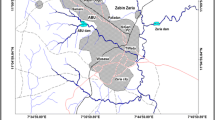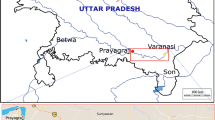Abstract
Monitoring of cyanobacteria and their associated toxins has intensified in raw water sources of drinking water treatment plants (WTPs) in most countries of the world. However, it is not explored yet for Egyptian WTPs. Therefore, this study was undertaken to investigate the occurrence of cyanobacteria and their microcystin (MC) toxins in the Nile River source water of Damietta WTP during warm months (April–September 2013) and to evaluate the removal efficiency of both cyanobacterial cells and MCs by conventional methods used in this plant as a representative of Egyptian drinking WTPs. The results showed that the source water at the intake of Damietta WTP contained dense cyanobacterial population (1.1–6.6 × 107 cells L−1) dominated by Microcystis aeruginosa. This bloom was found to produce MC-RR and MC-LR. Both cyanobacterial cell density and intracellular MCs in the intake source water increased with the increase in temperature and nutrients during the study period, with maximum values obtained in August. During treatment processes, cyanobacterial cells were incompletely removed by coagulation/flocculation/sedimentation (C/F/S; 91–96.8 %) or sand filtration (93.3–98.9 %). Coagulation/flocculation induced the release of MCs into the ambient water, and the toxins were not completely removed or degraded during further treatment stages (filtration and chlorination). MCs in outflow tank water were detected in high concentrations (1.1–3.6 μg L − 1), exceeding WHO provisional guideline value of 1 μg L − 1 for MC-LR in drinking water. Based on this study, regular monitoring of cyanobacteria and their cyanotoxins in the intake source water and at different stages at all WTPs is necessary to provide safe drinking water to consumers or to prevent exposure of consumers to hazardous cyanobacterial metabolites.







Similar content being viewed by others
References
Acero JL, Rodriguez E, Meriluoto J (2005) Kinetics of reactions between chlorine and the cyanobacterial toxins microcystins. Water Res 39:1628–1638
Amer R, Diez B, El-Shehawy R (2009) Diversity of hepatotoxic cyanobacteria in the Nile Delta, Egypt. J Environ Monit 11:126–133
American Public Health Association (APHA) (2005) Standard methods for the examination of water and wastewater. Washington, D.C.
Carey CC, Ibelings BW, Hoffmann EP, Hamilton DP, Brookes JD (2012) Eco-physiological adaptations that favor freshwater cyanobacteria in a changing climate. Water Res 46:1394–1407
Carmichael WW (1996) Toxic Microcystis and the environment. In: Watanabe MF, Harada KI, Carmichael WW, Fujiki H (eds) Toxic Microcystis. CRC Press, Boca Raton, pp 1–11
Carmichael WW, An J (1999) Using of enzyme linked immunosorbent assay (ELISA) and a protein phosphatase inhibition assay (PPIA) for the detection of MCYST and Nodularin. J Nat Toxins 7:377–385
Carmichael WW, Azevedo SMFO, An J, Molica RJR, Jochimsen EM, Lau S, Rinehart KL, Shaw GR, Eaglesham GK (2001) Human fatalities from cyanobacteria: chemical and biological evidence for cyanotoxins. Environ Health Perspect 109:663–668
Chorus I, Bartram J (1999) Toxic cyanobacteria in water: a guide to their public health consequences, monitoring and management. World Health Organization, E. and F.N. Spon. Routledge, London, 416 p
Chorus I, Niesel V, Fastner J, Wiedner C, Nixdorf B, Lindenschmidt KE (2001) Environmental factors and microcystin levels in water bodies. In: Chorus I (ed) Cyanotoxins: occurrence, cause, consequences. Springer-Verlag, Berlin, pp 159–177
Codd GA, Morrison LF, Metcalf JS (2005) Cyanobacterial toxins: risk management for health protection. Toxicol Appl Pharmacol 203:264–272
De la Cruz AA, Antoniou MG, Pelaez M, Hiskia A, Song W, O’Shea KE, He X, Dionysiou DD (2011) Can we effectively degrade microcystins?—implications for impact on human health status. Anticancer Agents Med Chem 11:19–37
Dittmann E, Wiegand C (2006) Cyanobacterial toxins-occurrence, biosynthesis and impact on human affairs. Mol Nutr Food Res 50:7–11
European Commission (2005) European Commission under the Fifth Framework Programme and contributing to the implementation of the key action “Sustainable management and quality of water”: best practice guidance for management of cyanotoxins in water supplies (Annex 1), p. 143
Ewerts H, Swanepoel A, du Preez HH (2013) Efficacy of conventional drinking water treatment processes in removing problem-causing phytoplankton and associated organic compounds. Water SA 39:739–949
Fan JJ, Hobson P, Ho L, Daly RI, Brookes J (2014) The effect of various control and water treatment processes on the membrane integrity and toxin fate of cyanobacteria. J Hazard Mater 264:313–322
Hegazy BEE (2012) Comparative study of different water treatment plants in Damietta Governorate, Egypt. Aust J Basic Appl Sci 6:474–482
Hisbergues M, Christiansen G, Rouhiainen L, Sivonen K, Borner T (2003) PCR-based identification of microcystin-producing genotypes of different cyanobacterial genera. Arch Microbiol 180:402–410
Ho L, Meyn T, Keegan A, Hoefel D, Brookes J, Saint CP, Newcombe G (2006) Bacterial degradation of microcystin toxins within a biologically active sand filter. Water Res 40:768–774
Ho L, Hoefel D, Palazot S, Sawade E, Newcombe G, Saint CP, Brookes JD (2010) Investigations into the biodegradation of microcystin-LR in wastewaters. J Hazard Mater 180:628–633
Hoeger SJ, Shaw G, Hitzfeld BC, Dietrich DR (2004) Occurrence and elimination of cyanobacterial toxins in two Australian drinking water treatment plants. Toxicon 43:639–649
Hoeger SJ, Shaw G, Hitzfeld BC, Dietrich DR (2005) Occurrence and elimination of cyanobacterial toxins in drinking water treatment plants. Toxicol Appl Pharmacol 203:231–242
Huber V, Wagner C, Gerten D, Adrian R (2012) To bloom or not to bloom: contrasting responses of cyanobacteria to recent heat waves explained by critical thresholds of abiotic drivers. Oecologia 169:245–256
Indabawa II (2009) Detection of variants of microcystin produced by Microcystis aeruginosa in some burrow pits of Kano, Nigeria. Bayero J Pure Appl Sci 2:189–197
Komárek J, Anagnostidis K (2005) Cyanoprokaryota, Süßwasserflora von Mitteleuropa, Gustav Fischer, Jena Stuttgart Lübeck Ulm
Lawton LA, Beattie KA, Hawser SP, Campbell DL, Codd GA (1994) Evaluation of assay methods for the determination of cyanobacterial hepatotoxicity. In: Codd GA, Jefferies TM, Keevil CW, Potter E (eds) Detection methods for cyanobacterial toxins. The Royal Society of Chemistry, London, pp 111–116
Lévesque B, Gervais M-C, Chevalier P, Gauvin D, Anassour-Laouan-Sidi E, Gingras S, Fortin N, Brisson G, Greer C, Bird D (2014) Prospective study of acute health effects in relation to exposure to cyanobacteria. Sci Total Environ 466–467:397–403
Long BM, Jones GJ, Orr PT (2001) Cellular microcystin content in N-limited Microcystis aeruginosa can be predicted from growth rate. Appl Environ Microbiol 67:278–283
Manage PM, Edwards C, Lawton LA (2010) Bacterial degradation of microcystin. In: Hamamura N, Suzuki S, Mendo S, Barroso CM, Iwata H, Tanabe S (Eds) Biological responses to contaminants. Interdisc. Stud. Environ. Chem. 3; 97–104
Mohamed ZA (2008) Toxic cyanobacteria and cyanotoxins in public hot springs in Saudi Arabia. Toxicon 51:17–27
Mohamed ZA (2011) Cyanotoxins in Egypt and Saudi Arabia, In: Nriagu JO (Ed) Encyclopedia of environmental health. Burlington, Elsevier, pp. 872–880
Mohamed ZA, Al-Shehri AM (2009a) Microcystins in groundwater wells and their accumulation in vegetable plants irrigated with contaminated waters in Saudi Arabia. J Hazard Mater 172:310–315
Mohamed ZA, Al-Shehri AM (2009b) Microcystin-producing bloom of Anabaenopsis arnoldi in a potable mountain lake In Saudi Arabia. FEMS Microbiol Ecol 69:98–105
Mohamed ZA, Al-Shehri AM (2013) Assessment of cylindrospermopsin toxin in an arid Saudi lake containing dense cyanobacterial bloom. Environ Monit Assess 185:2157–2166
Mohamed ZA, Carmichael WW (2000) Seasonal variation in microcystin levels of River Nile water at Sohag city, Egypt. Ann Limnol 36:227–234
Mohamed ZA, Carmichael WW, Hussein AA (2003) Estimation of microcystins in the freshwater fish farm containing a Microcystis bloom. Environ Toxicol 18:137–141.
Mohamed ZA, El-Sharouny HM, Ali WSM (2007) Microcystin concentrations in the Nile River sediments, and removal of microcystin-LR by sediments during batch experiments. Arch Environ Contam Toxicol 52:489–495
O’Neil JM, Davis TW, Burford MA, Gobler CJ (2012) The rise of harmful cyanobacteria blooms: the potential roles of eutrophication and climate change. Harmful Algae 14:313–334
Oliver RL, Ganf GG (2000) Freshwater blooms. In: Whitton BA, Potts M (eds) The ecology of cyanobacteria, their diversity in time and space. Kluwer Academic, Dordrecht, pp 149–194
Organization for Economic Cooperation and Development (OECD) (1982) Eutrophication of waters. monitoring, assessment and control. Final Report. OECD Cooperative Programme on Monitoring of Inland Waters (Eutrophication Control), Environment Directorate, OECD, Paris
Pantelic D, Svircev Z, Simeunovic J, Vidovic M, Trajkovic I (2013) Cyanotoxins: characteristics, production and degradation routes in drinking water treatment with reference to the situation in Serbia. Chemosphere 91:421–441
Petr Z, Tomasz J, Jaroslava K, Jitka J, Joanna M, Klara K, Eliska Z (2006) Summer changes in cyanobacterial bloom composition and microcystin concentration in Eutrophic Czech reservoirs. Environ Toxicol 21:236–243
Pietsch J, Bornmann K, Schmidt W (2002) Relevance of intra and extracellular cyanotoxins for drinking water treatment. Acta Hydrochim Hydrobiol 30:7–15
Sivonen K, Jones G (1999) Cyanobacterial toxins. In: Chorus I, Bartram J (eds) Toxic cyanobacteria in water: a guide to public health significance, monitoring and management. WHO/Spon, London, pp 41–111
Song L, Chen W, Peng L, Wana N, Gan N, Zhang X (2007) Distribution and bioaccumulation of microcystins in water columns: a systematic investigation into the environmental fate and the risks associated with microcystins in Meiliang Bay, Lake Taihu. Water Res 41:2853–2864
Sotero-Santos RB, Silva CRD, Verani NF, Nonka KO, Rocha O (2006) Toxicity of a cyanobacteria bloom in Barra Bonita reservoir (Middle Tiete River, Sao Paulo Brazil). Ecotoxicol Environ Saf 64:163–170
Svircev Z, Simeunovic J, Subakov-Simic G, Krstic S, Vidovic M (2007) Freshwater cyanobacterial blooms and cyanotoxin production in Serbia in the past 25 years. Geogr Pannonica 11:32–38
Svircev Z, Krstic S, Miladinov-Miko M, Baltic V, Vidovic M (2009) Freshwater cyanobacterial blooms and primary liver cancer epidemiological studies in Serbia. J Environ Sci Health C 1532–4095:36–55
Talling JF, Driver O (1963) Some problems in the estimation of chlorophyll a in phytoplankton. In: Doty M (ed) Primary productivity measurements, marine and freshwater. US Atomic Energy Commission, Washington, pp 142–146
Teixeira RM, Rosa MJ (2006) Comparing dissolved air flotation and conventional sedimentation to remove cyanobacterial cells of Microcystis aeruginosa. Part I: the key operating conditions. Sep Purif Technol 52:84–94
Teixeira MR, Rosa MJ (2007) Comparing dissolved air flotation and conventional sedimentation to remove cyanobacterial cells of Microcystis aeruginosa. Part II. The effect of water background organics. Sep Purif Technol 53:126–134
Teixeira MR, Sousa V, Rosa MJ (2010) Investigating dissolved air flotation performance with cyanobacterial cells and filaments. Water Res 44:3337–3344
Tsuji K, Masui H, Uemura H, Mori Y, Harada KI (2001) Analysis of MCYSTs in sediments using MMPB method. Toxicon 39:687–692
Utkilen H, Skulberg OM, Skulberg R, Gjølme N, Underdal B (2001) Toxic cyanobacterial blooms of inland waters in southern Norway 1978–1998. In: Chorus I (ed) Cyanotoxins. Springer, Berlin, pp 46–49
World Health Organization (WHO) (1998) Guidelines for drinking water quality. Addendum to Volume 1. Recommendations. 2nd edn., World Health Organization, 36 p
Wu SK, Xie P, Liang GD, Wang SB, Liang XM (2006) Relationships between microcystins and environmental parameters in 30 subtropical shallow lakes along the Yangtze River, China. Freshw Biol 51:2309–2319
Zamyadi A, MacLeod S, Fan Y, McQuaid N, Dorner S, Sauve S, Prevost M (2012) Toxic cyanobacterial breakthrough and accumulation in a drinking water plant: a monitoring and treatment challenge. Water Res 46:1511–1523
Zamyadi A, Fan Y, Daly RI, Prevost M (2013) Chlorination of Microcystis aeruginosa :toxin release and oxidation, cellular chlorine demand and disinfection by-products formation. Water Res 47:1080–1090
Conflict of interest
The authors declare that they have no conflict of interest.
Ethical statement
We all the authors of the manuscript “Occurrence of cyanobacteria and microcystin toxins in raw and treated waters of the Nile River, Egypt: Implication for water treatment and human health” agree upon standards of expected ethical behavior for all parties involved in the act of publishing.
Author information
Authors and Affiliations
Corresponding author
Additional information
Responsible editor: Philippe Garrigues
Rights and permissions
About this article
Cite this article
Mohamed, Z.A., Deyab, M.A., Abou-Dobara, M.I. et al. Occurrence of cyanobacteria and microcystin toxins in raw and treated waters of the Nile River, Egypt: implication for water treatment and human health. Environ Sci Pollut Res 22, 11716–11727 (2015). https://doi.org/10.1007/s11356-015-4420-z
Received:
Accepted:
Published:
Issue Date:
DOI: https://doi.org/10.1007/s11356-015-4420-z




